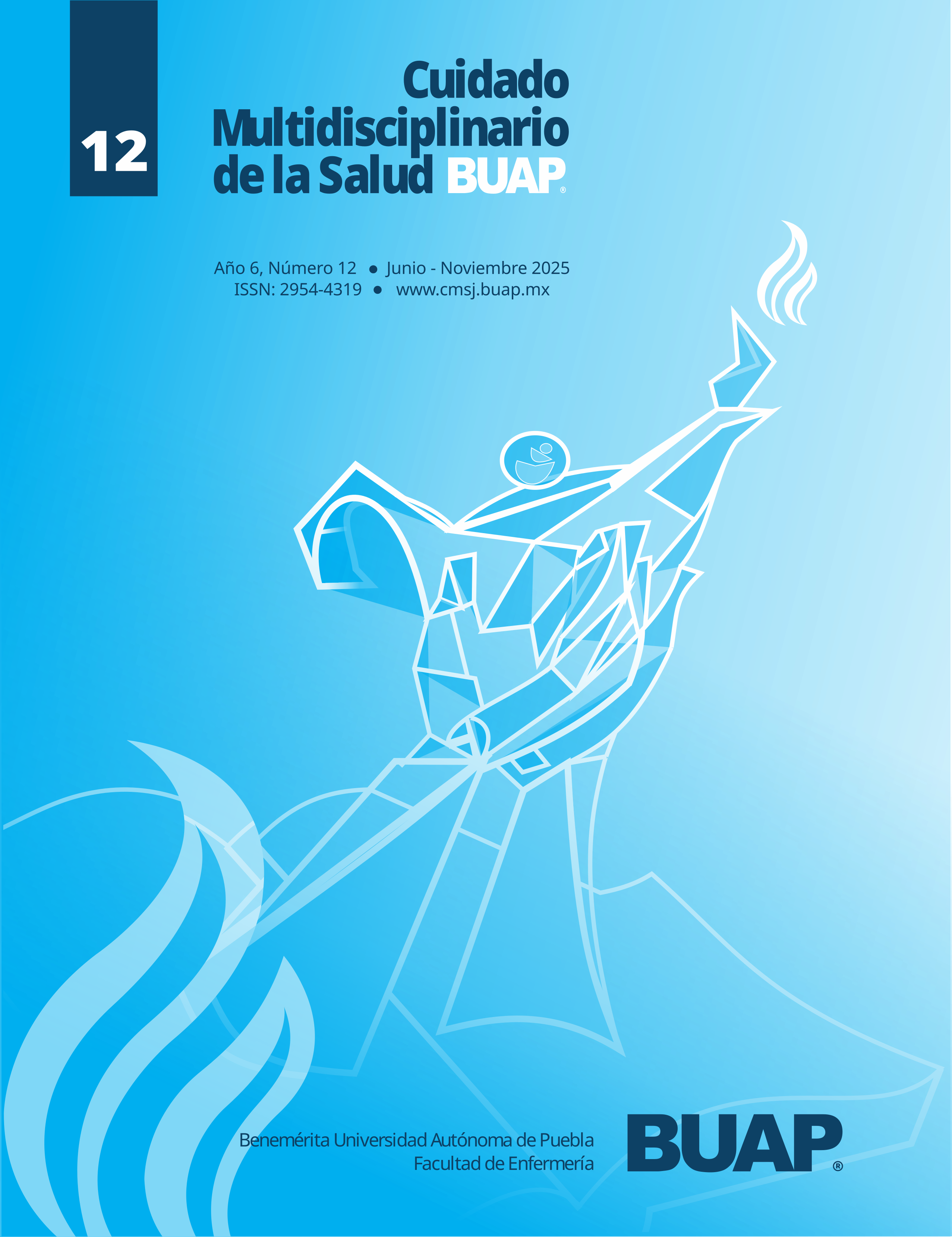Level of knowledge of breast self-examination technique through educational intervention
Keywords:
knowledge, self-examination, educational intervention, breast cancer, nursingAbstract
Introduction. Breast cancer represents the leading cause of death from malignant tumors, mainly in women. In Mexico, in 2022, there were 23,790 new cases of breast cancer registered among the population aged 20 years and older. The literature review does not show recent educational interventions to improve the level of knowledge in breast self-examination in central Mexico.
Objective. To determine the effect of an educational intervention on the level of knowledge about the breast self-examination technique in women from an urban population of Mexico City.
Methodology. Pre-experimental, comparative and longitudinal design. The sample consisted of 49 women aged 20 to 60 years, from an urban area of Mexico City, who agreed to participate with informed consent.
Results. In general, the level of pre-knowledge was 35.71 % and post-intervention knowledge was 64.62 % showing a positive increase of 28.91 %.
Conclusions. The level of knowledge before the educational intervention was deficient; likewise, the efficiency of the educational intervention was demonstrated, by registering a considerable post-intervention level of knowledge as good. It was also identified the negative influence of different social determinants. It is important to emphasize that health education is an effective method with the support of digital tools according to the type of population to increase the level knowledge. As it was mentioned before, the educational interventions increase knowledge in women giving them competencies the detect breast cancer on early stages.
References
Barrios, C.H. (2022). Global challenges in breast cancer detection and treatment. The Breast, 62(suppl 1), S3-S6. https://doi.org/10.1016/j.breast.2022.02.003
Ceballos, G. L., Soto, L. M. & Villa, V. (2024). Cáncer de Mamá: Experiencias de mujeres frente al diagnóstico, tratamiento y cambios en su vida sexual [Tesis]. Fundación Universitaria del Areandina.
Pereira, Colombia. https://digitk.areandina.edu.co/entities/publication/dcb86cb5-8787-444f-8e05-e7172d9df28d
Centro Nacional de Equidad de Género y Salud Reproductiva [CNEGSR]. (2024). Prevención, Diagnóstico, Tratamiento, Control y Vigilancia Epidemiológica del Cáncer de Mama en México. Secretaría de Salud. https://www.gob.mx/cms/uploads/attachment/file/952441/Lineamiento_T_cnico_PDTCVE_CaMa_en_M_xico.pdf
Chilán, C. I., Loor, M. A., Loor, C. J., García, A.M., García, C.D. & López, A. N. (2024). Cáncer de Mama: prevalencia, factores de riesgo y signos en la población. Revista INVECOM, 4(2), 1-15. https://doi.org/10.5281/zenodo.10612175
Colunga, S. & Moya, J. L. (2023). Salutogénesis, sanación y curación. Revista Humanidades Médicas, 23(1), 1-21. https://humanidadesmedicas.sld.cu/index.php/hm/article/view/2512
González, G., Peralta, O. & De la Rosa, D. J. (2019). Impacto de una intervención educativa en el conocimiento del cáncer de mama en mujeres colombianas. Revista Cubana de Salud Pública, 45(3), e1157, 1-15. https://revsaludpublica.sld.cu/index.php/spu/article/view/1157
Gotzsche, P. (2021). Mammography Screening. Truth, Lies and Controversy [Mamografía de detección: verdad, mentiras y controversia] (1a. ed.). CRC Press. https://doi.org/10.1201/9781846198410
Hernández, M., Llamas, I. S. & Campos, A. A. C. (coords.). (2022). La labor del académico universitario en el fomento de la salud física y emocional (pp. 339-344). Universidad Juárez Autónoma de Tabasco.
Instituto Nacional de Salud Pública [INSP]. (2020). Cáncer de mama una prioridad para la salud de las mexicanas. Gobierno de México. https://www.insp.mx/avisos/5090-octubre-cancer-mama-19.html
Instituto Nacional de Estadística Geografía e Informática [INEGI]. (16 de octubre de 2024). Estadísticas a propósito del día internacional de la lucha contra el cáncer de mama [Comunicado de prensa núm. 599/24]. https://www.inegi.org.mx/contenidos/saladeprensa/aproposito/2024/EAP_LuchaC-Mama24.pdf
Martínez, A., Martín, R., Arasanz, L., Fernández, M. M. & Cachero, J. (2022). Efectividad de una intervención educativa para la prevención del cáncer de mama mediante una web-app. Revista Oficial de la Sociedad Española de Enfermería Oncológica, 24(1), 8-25. https://revista.proeditio.com/enfermeriaoncologica/article/view/4311/6794
NORMA Oficial Mexicana NOM-041-SSA2-2011, Para la prevención, diagnóstico, tratamiento, control y vigilancia epidemiológica del cáncer de mama. (2011). Diario Oficial de la Federación [DOF]. Secretaría de Gobernación. https://dof.gob.mx/nota_detalle.php?codi-
go=5194157&fecha=09/06/2011#gsc.tab=0
Organización Panamericana de la Salud [OPS]. (2023). Cáncer de mama. https://www.paho.org/es/temas/cancemama#:~:text=Las%20Am%C3%A9ricas%20representaron%20casi%20un-
a,Am%C3%A9rica%20del%20Norte%20(19%25)
Organización Mundial de la Salud [OMS]. (2024). Cáncer de mama. https://www.who.int/es/newsroom/fact-sheets/detail/breast-cancer#:~:text=Magnitud%20del%20problema,48%20morir%C3%A1%20por%20esa%20enfermedad.
Palmero, J., Lassard, J., Juárez, L.A. & Medina, C. A. (2021). Cáncer de mama: una visión general. Acta Médica Grupo Angeles, 19(3), 354–360. https://doi.org/10.35366/101727
Reglamento De La Ley General De Salud En Materia De Investigación Para La Salud. (04 de abril de 2014). Diario Oficial de la Federación [DOF]. Secretaría de Gobernación. https://www.diputados.gob.mx/LeyesBiblio/regley/Reg_LGS_MIS.pdf
Suárez, C., Pérez, L.M. & Téllez, I. (2023). Impacto de una intervención educativa en el nivel de conocimientos y autoeficacia en autoexploración mamaria. South Florida Journal of Development, 4(6), 2370-2380. https://doi.org/10.46932/sfjdv4n6-013
Torres-Agüero, N. C., López-Catá, F. J., Loret de Mola, E. J. P. & Agüero Betancourt, C. M. (2021). Intervención educativa sobre factores de riesgo del cáncer de mama en mujeres de 20 a 40 años. Universidad Médica Pinareña, 17(1), e485, 1-10. https://revgaleno.sld.cu/index.php/ump/article/view/485
Downloads
Published
How to Cite
Issue
Section
License
Copyright (c) 2025 The moral rights belong to the author, the economic rights belong to the Benemérita Universidad Autónoma de Puebla.

This work is licensed under a Creative Commons Attribution-NonCommercial-NoDerivatives 4.0 International License.
The moral rights belong to the author, the economic rights belong to the Benemérita Universidad Autónoma de Puebla.






